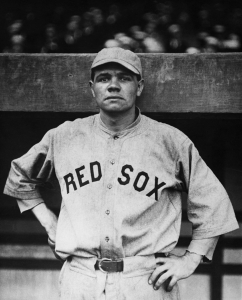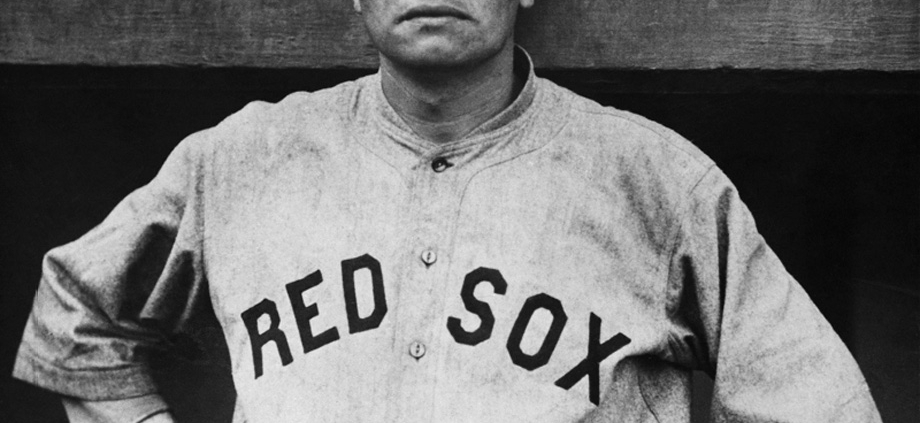May 20, 1916: Babe Ruth replaced in 6th inning while throwing a no-hitter
 Young Babe Ruth, 21, gave out plenty of free passes on this Saturday afternoon. He walked seven Browns batters in six innings of work. The lefty didn’t allow a hit, though, and got some help from his St. Louis counterparts, who allowed eight bases on balls.
Young Babe Ruth, 21, gave out plenty of free passes on this Saturday afternoon. He walked seven Browns batters in six innings of work. The lefty didn’t allow a hit, though, and got some help from his St. Louis counterparts, who allowed eight bases on balls.
Ruth improved his won-lost mark in the young season to 5-2. Maybe he was a bit rusty. The Babe had last pitched 10 days earlier, a complete-game 6-2 loss to Cleveland.
Boston entered the game 13-15; the St. Louis Browns were 11-16 and had knocked off the Red Sox, 7-1 and 5-1, in the two previous games. The reigning world champion Red Sox were struggling some in the 1916 campaign.
The game was originally scheduled to start at 3 P.M. but was delayed until 4:09 due to a heavy rain shower. A band concert and a “boy soprano” entertained the 5,232 patrons until groundskeeper Jerome Kelley and his crew were able to put the field into playing shape.1
St. Louis went ahead in the top of the fourth inning. Ruth walked left fielder Burt Shotton and shortstop Ernie Johnson, and both advanced a base on a sacrifice by George Sisler. Ruth got Ward Miller to hit a grounder that second baseman Jack Barry fielded and fired home to the catcher for an out. Johnson took third on the play. Miller and Johnson then executed a double steal, Johnson scoring. After that, Ruth retired the side. He still hadn’t given up a hit, but the Red Sox were down 1-0.
At the risk of repetition, perhaps we can pause and enjoy the Boston Herald’s description of how the Browns scored their run. The writing was exceptionally florid, even by the standards of the day: “After Catcher Thomas had been banished, and Agnew stepped in, George Sisler suicided his pals along. On Miller’s smack to Barry, Shotton was torpedoed at the saucer, Johnson meantime trotting to third. Then the two Browns started a double pilfer. Agnew pegged to Janny [Hal Janvrin], who was so busy chasing Miller that he forgot all about the chap on third, who naturally took advantage and scored.”2
The Red Sox scored twice in the bottom of the fourth. First, they loaded the bases on a single, a walk, and another single. Browns starter Dave Davenport then walked Hal Janvrin on four pitches, forcing in the tying run. Catcher Sam Agnew hit a sacrifice fly to left field that scored Tillie Walker and ended the day for Davenport, one of four pitchers the Browns used during this low-scoring game. Reliever Jim Park prevented any more runs from scoring. In fact, he didn’t allow a hit in his 2⅔ innings of work.
Ruth got through the fifth inning without allowing a hit and had even nicely picked off Sisler in the first inning. He ran into control problems in the sixth. It should be mentioned here that although Ruth doled out seven walks in the game, the Boston Globe suggested that he might not have been completely at fault. Early in the game, the newspaper said, “the big portsider was getting much the worst of it from Umpire Nallin on balls and strikes. Babe thought so and so did ‘Ginger’ Thomas, the latter giving such vent to his disgust that Nallin banished him, but not before the Red Sox catcher had thrown his mask at Nallin’s feet and let loose a little more conversation.”3 Agnew had taken his place. Later in the game, the Red Sox used a third catcher, Hick Cady. The Boston Herald noted that both teams had differences with plate umpire Dick Nallin. By game’s end, there were 17 walks in the game, eight by Browns pitchers and nine by the Red Sox.
Despite the challenging state of the field, the game featured two great catches by Red Sox right fielder Harry Hooper, one saving the Sox in the sixth, and the other in the seventh, quashing another rally.
Ruth gave up three walks to fill the bases with Browns in the top of the sixth. There were two outs when the Babe was “mercifully derricked,”4 still without having given up a hit. Red Sox manager Bill Carrigan brought in Carl Mays to pitch to Del Pratt, who hit a ball deep to right that Hooper hauled in for the final out of the inning. Or, as the Globe put it, “Modest Harry, after a long chase, pulled down Pratt’s drive.”5
In the seventh, the Browns put runners on first and second with one out. Pinch-hitter Babe Borton hit “what looked to be a sure triple” (Globe). Hooper, though, made a spectacular catch and threw to Barry at second base for the third out after both St. Louis baserunners had confidently taken off, looking to give the Browns a 3-2 lead. The Herald described the play: “Through the spike-scarred marshes of right field, Harry Hooper splashed and plashed in the murky gloom. … Skimming over a puddle with the grace of a swallow, Harry stuck up his hands. He snatched the hurtling baseball out of murk. He turned and pegged the baseball in to Jack Barry.”6 Hooper’s catch was, writer Flatley remarked, “one of the greatest he or anybody else ever made.”
The Red Sox held their 2-1 lead before adding one more run in the bottom of the seventh. Agnew walked and Carl Mays singled up the middle. Carrigan had Mike McNally pinch-run for Agnew. Hooper flied out to left. Barry singled over the shortstop, but McNally needed to hold. The bases were loaded with one out. Duffy Lewis hit the ball hard to Johnson at shortstop, and Johnson threw home, nabbing McNally. Tom McCabe, the fourth St. Louis pitcher of the day, walked Dick Hoblitzell, forcing in Mays with the insurance run.
There were the 17 walks in the game, and, ultimately, just two hits for the Browns and six for the Red Sox. The Browns left seven runners on base, and the Red Sox stranded nine. Given the playing conditions, it was remarkable that no team committed an error. The game was played in 2 hours and 16 minutes.
At the plate, Ruth went 0-for-2 and his average in the still-young season was just .071. He finished the campaign with a .272 average and had three home runs, one short of the four he had hit in 1915, to that point his career high.
His pitching record for 1916 was 23-12, with a league-leading 1.75 earned-run average, in part built on nine shutouts, which also led the league. The Red Sox recovered from their slow start and won a second straight World Series championship, this time knocking off the Brooklyn Robins in five games.
Sources
In addition to the sources cited in the Notes, the author also relied on Baseball-Reference.com and Retrosheet.org.
Notes
1 “Red Sox Break Spell, Beating Browns 3-1,” Boston Globe, May 21, 1916: 15.
2 N.J. Flatley, “Hooper’s Great Catch Saved Day for the Red Sox,” Boston Herald, May 21, 1916: 22.
3 “Red Sox Break Spell, Beating Browns 3-1.”
4 N.J. Flatley.
5 “Red Sox Break Spell, Beating Browns 3-1.”
6 N.J. Flatley.
Additional Stats
Boston Red Sox 3
St. Louis Browns 1
Fenway Park
Boston, MA
Box Score + PBP:
Corrections? Additions?
If you can help us improve this game story, contact us.


